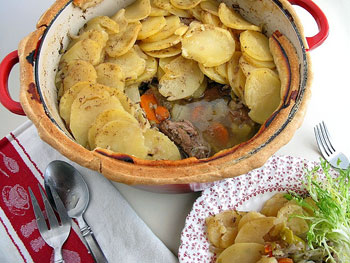 When I think of casseroles, I imagine layers and layers of meats and
vegetables slowly cooking together until fork tender. Baeckeoffe is
that casserole; it beats all other casseroles. Beef, lamb, and pork are
combined with onions, leeks, and carrots, then drowned in wine, and
slowly braised for hours in the oven until just perfect. Baeckeoffe,
which translates to baker's oven, originates from Alsace, France, a
region that has changed hands many times between France and Germany. In
many ways, especially gastronomically, it maintains a German identity.
Here you will find beer, sausages, sauerkraut, and vineyards growing
typical German grapes like Riesling and Gewürztraminer. Many dishes are
specific to this region, Baeckeoffe being one of its most famous
traditional foods.
When I think of casseroles, I imagine layers and layers of meats and
vegetables slowly cooking together until fork tender. Baeckeoffe is
that casserole; it beats all other casseroles. Beef, lamb, and pork are
combined with onions, leeks, and carrots, then drowned in wine, and
slowly braised for hours in the oven until just perfect. Baeckeoffe,
which translates to baker's oven, originates from Alsace, France, a
region that has changed hands many times between France and Germany. In
many ways, especially gastronomically, it maintains a German identity.
Here you will find beer, sausages, sauerkraut, and vineyards growing
typical German grapes like Riesling and Gewürztraminer. Many dishes are
specific to this region, Baeckeoffe being one of its most famous
traditional foods.
The most appealing features of the dish are
its minimum supervision to make and ability to feed a large, busy
family—of particular interest in olden times. As the story goes,
Alsatian women would drop off their casseroles with the local baker on
Monday, which was the day set aside for doing laundry. The baker, who
may have had many casseroles in his oven at one time, used a rope of
dough between the rim and lid of each casserole to form a tight seal
and keep in moisture. The low, steady temperature of the baker's oven
was the ideal environment for cooking the Baeckeoffe. Once the women
finished their chores, the children returned from school, and the
husbands returned from work, the casseroles would be ready for
retrieval from the baker.
The
key step in making Baeckeoffe is to marinate the three types of meats
and vegetables overnight with Riesling, allowing the meats to be
permeated with its fruity flavors. The Baeckeoffe is ready for baking
the next morning. But first, thin slices of Yukon gold potatoes line
the bottom of the pot, followed by the marinated mixture, covered with
more potato slices. Waxy potatoes such as Yukon gold or red-skinned
work the best, because they keep their shape during the long cooking
time. Another bottle of Riesling tops the contents before the rim is
fitted with a traditional rope of dough to seal the lid. This step
cannot be omitted, otherwise the liquid can bubble out of the pot and
into the oven. The cooking environment that this creates is very
similar to that created by a pressure cooker. The resulting meal will
be luscious, moist, and flavorful. This winter season make hearty
Baeckeoffe for your family.
Baeckeoffe
Adapted from The Cuisine of Hubert Keller by Hubert Keller with John Harrison.
Note: For this recipe I use a Dutch oven, but if you can find it, a clay tureen is more traditional and possibly better.
for the marinade:
1 pound beef chuck, cut into 1-1/4-inch chunks
1 pound pork butt, cut into 1-1/4-inch chunks
1 pound lamb shoulder, cut into 1-1/4-inch chunks
2 yellow onions, minced
3 garlic cloves, minced
2 small leeks, white and light-green parts only, julienned
1 large carrot, cut into 1/8-inch slices
2 bay leaves
1 sprig thyme
1 teaspoon juniper berries
3 tablespoons minced parsley
1 750-ml bottle Riesling
for the assembly:
olive oil
3 pounds Yukon gold potatoes, peeled and cut into 1/8-inch slices
fine sea salt
freshly ground black pepper
1 750-ml bottle Riesling
3/4 cup all-purpose flour
5 tablespoons water
For
the marinade, combine meat, vegetables, herbs, and wine in a large
glass or ceramic bowl or dish. Cover with plastic wrap and refrigerate
overnight.
Preheat oven to 350 degrees F. Rub the inside of a 6-quart Dutch oven with oil.
To
assemble the casserole, line bottom of Dutch oven with half the potato
slices. Season with salt and pepper. Pack in meat and vegetables in
layers. Season with salt and pepper. Pour in marinade. Cover meat and
vegetables with the remaining potato slices. Season with salt and
pepper. Pour in wine just until potatoes are covered with liquid.
Make
a paste by combining flour, water, and 1 tablespoon oil. Knead and roll
into a long snake. Place around the rim of the Dutch oven. Slightly
loosen the screw of the knob on the lid to create a vent hole. Place
the lid on the dough and press tightly to seal.
Place the Dutch
oven on a rimmed baking sheet and into the oven. Bake for 3 hours.
Remove the lid with the pastry. Serve piping hot. Yield: 6 to 8
servings.
Joseph Erdos is a New York–based writer and editor, but above all a gastronomer and oenophile. He shares his passion for food on his blog, Gastronomer's Guide , which features unique recipes and restaurant reviews among many other musings on the all-encompassing topic of food.


